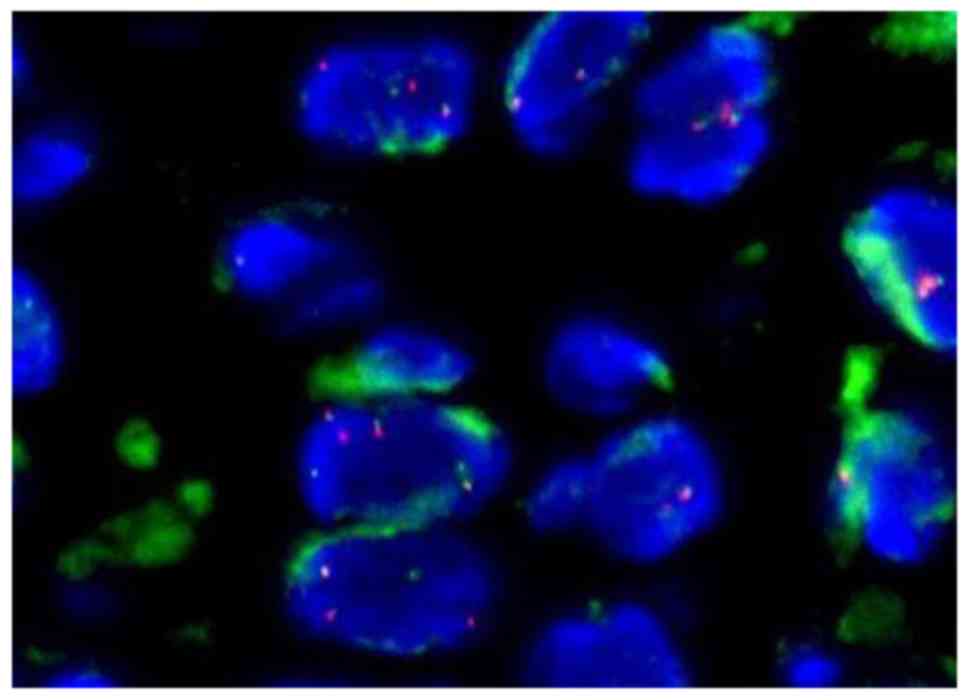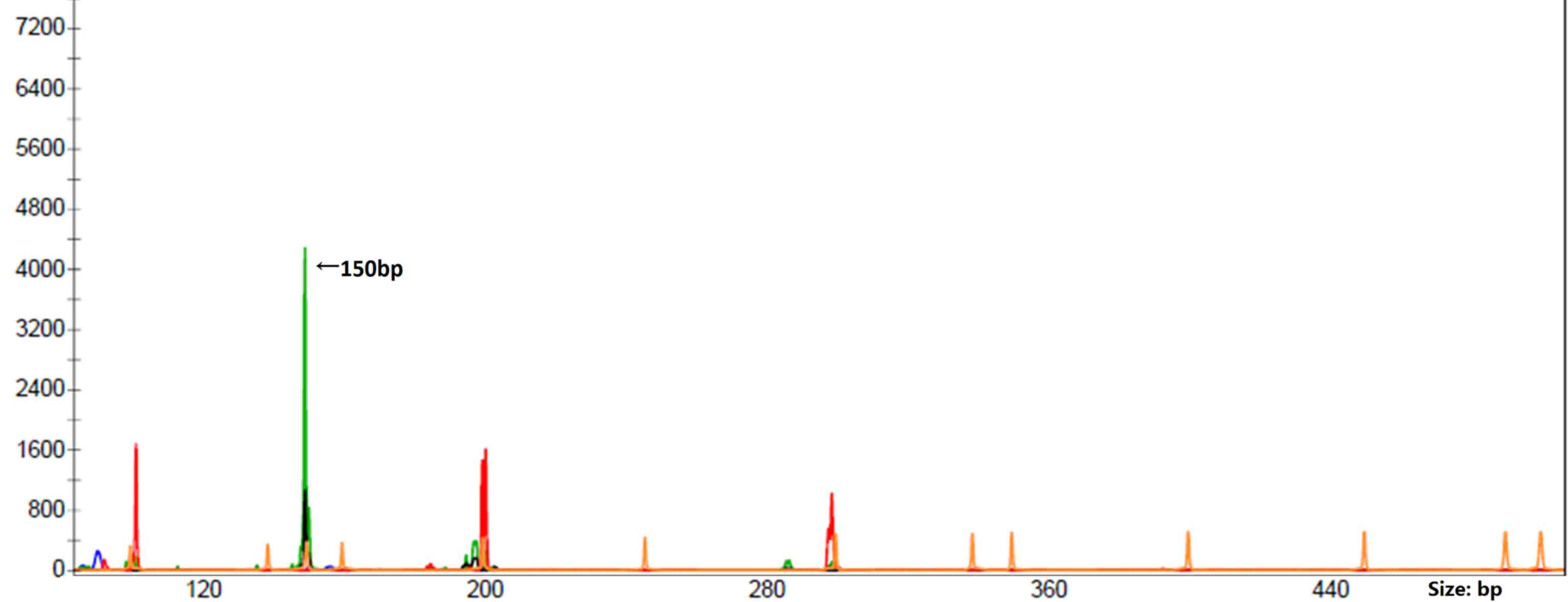|
1
|
Swerdlow SH, Campo E, Harris N.L, Jaffe
E.S, Pileri S.A, Stein H, Thiele J and Vardiman J.W: WHO
classification tumours of haematopoietic and lymphoid tissues. 4th.
Lyon, France: IARC Press; pp. 244–255. 2008
|
|
2
|
Delsol G, Lamant L, Mariamé B, Pulford K,
Dastugue N, Brousset P, Rigal-Huguet F, Al Saati T, Cerretti DP,
Morris SW and Mason DY: A new subtype of large B-cell lymphoma
expressing the ALK kinase and lacking the 2; 5 translocation.
Blood. 89:1483–1490. 1997.PubMed/NCBI
|
|
3
|
Laurent C, Do C, Gascoyne RD, Lamant L,
Ysebaert L, Laurent G, Delsol G and Brousset P: Anaplastic lymphoma
kinase-positive diffuse large B-cell lymphoma: A rare
clinicopathologic entity with poor prognosis. J Clin Oncol.
27:4211–4216. 2009. View Article : Google Scholar : PubMed/NCBI
|
|
4
|
Huang RF, CHEN G, GONG LP and LU LL:
Pathologic and molecular genetic study of anaplastic lymphoma
kinase-positive large B-cell lymphoma. Zhonghua Bing Li Xue Za Zhi.
40:169–172. 2011.(In Chinese). PubMed/NCBI
|
|
5
|
Yu H, Huang J, Sun J, Wang C, Lin M and Li
H: Anaplastic lymphoma kinase-positive large B-cell lymphoma: A
potential diagnostic pitfall. Indian J Pathol Microbiol.
58:241–245. 2015. View Article : Google Scholar : PubMed/NCBI
|
|
6
|
Gustmann C, Altmannsberger M, Osborn M,
Griesser H and Feller AC: Cytokeratin expression and vimentin
content in large cell anaplastic lymphomasand other non-Hodgkin's
lymphomas. Am J Pathol. 138:1413–1422. 1991.PubMed/NCBI
|
|
7
|
Zhang Q, Ming J, Zhang S, Li B, Han X and
Qiu X: Cytokeratin positivity in anaplastic large cell lymphoma: A
potential diagnostic pitfall in misdiagnosis of metastatic
carcinoma. Int J Clin Exp Pathol. 6:798–801. 2013.PubMed/NCBI
|
|
8
|
Nguyen TT, Kreisel FH, Frater JL and
Bartlett NL: Anaplastic large cell lymphoma with aberrant
expression of multiple cytokeratins masquerading as metastatic
carcinoma of unknown primary. J Clin Oncol. 31:e443–e445. 2013.
View Article : Google Scholar : PubMed/NCBI
|
|
9
|
Shi Y and Li X: Clinicopathologic features
and association with Epstein-Barr virus infection in 235 cases of
Hodgkin lymphoma from northern China. Zhonghua Bing Li Xue Za Zhi.
44:84–89. 2015.(In Chinese). PubMed/NCBI
|
|
10
|
Lin SY, Chuang SS, Jhuang JY, Sakamoto K,
Takeuchi K, Bahrami A and Tsai CC: ALK positive large B-cell
lymphoma with a massive neutrophilic infiltrate: Report of a case
mimicking epithelioid inflammatory myofibroblastic tumour. J Clin
Pathol. 68:496–498. 2015. View Article : Google Scholar : PubMed/NCBI
|
|
11
|
Reichard KK, McKenna RW and Kroft SH:
ALK-positive diffuse large B cell lymphoma: Report of four cases
and review of the literature. Mod Pathol. 20:310–319. 2007.
View Article : Google Scholar : PubMed/NCBI
|
|
12
|
Rudzki Z, Rucińska M, Jurczak W, Skotnicki
AB, Maramorosz-Kurianowicz M, Mruk A, Piróg K, Utych G, Bodzioch P,
Srebro-Stariczyk M, et al: ALK-positive diffuse largeB-cell
lymphoma: Two more cases and a brief literature review. Pol J
Pathol. 56:37–45. 2005.PubMed/NCBI
|
|
13
|
Onciu M, Behm FG, Downing JR, Shurtleff
SA, Raimondi SC, Ma Z, Morris SW, Kennedy W, Jones SC and Sandlund
JT: ALK-positive plasmablastic B-cell lymphoma with expression of
the NPM-ALK fusion transcript: Report of 2 cases. Blood.
102:2642–2644. 2003. View Article : Google Scholar : PubMed/NCBI
|
|
14
|
Adam P, Katzenberger T, Seeberger H,
Gattenlöhner S, Wolf J, Steinlein C, Schmid M, Müller-Hermelink HK
and Ott G: A case of a diffuse large B-cell lymphoma of
plasmablastic type associated with the t(2;5)(p23;q35) chromosome
translocation. Am J Surg Patho. 27:1473–1476. 2003. View Article : Google Scholar
|
|
15
|
Lee HW, Kim K, Kim W and Ko YH:
ALK-positive diffuse large B-cell lymphoma: Report of three cases.
Hematol Oncol. 26:108–113. 2008. View
Article : Google Scholar : PubMed/NCBI
|
|
16
|
Shi M, Miron PM, Hutchinson L, Woda BA,
Nath R, Cerny J and Yu H: Anaplastic lymphoma kinase-positive large
B-cell lymphoma with complex karyotype and novel ALK gene
rearrangements. Hum Pathol. 42:1562–1567. 2011. View Article : Google Scholar : PubMed/NCBI
|
|
17
|
Gascoyne RD, Lamant L, Martin-Subero JI,
Lestou VS, Harris NL, Müller-Hermelink HK, Seymour JF, Campbell LJ,
Horsman DE, Auvigne I, et al: ALK-positive diffuse large B-cell
lymphoma is associated with Clathrin-ALK rearrangements: Report of
6 cases. Blood. 102:2568–2573. 2003. View Article : Google Scholar : PubMed/NCBI
|
|
18
|
de Paepe P, Baens M, van Krieken H,
Verhasselt B, Stul M, Simons A, Poppe B, Laureys G, Brons P,
Vandenberghe P, et al: ALK activation by the CLTC-ALK fusion is a
recurrent eventin in large B-cell lymphoma. Blood. 102:2638–2641.
2003. View Article : Google Scholar : PubMed/NCBI
|
|
19
|
Rogers MA, Langbein L, Winter H, Ehmann C,
Praetzel S, Korn B and Schweizer J: Characterization of a cluster
of human high/ultrahigh sulfur keratin-associated protein genes
embedded in the type I keratin gene domain on chromosome 17q12-21.
J Biol Chem. 276:19440–19451. 2001. View Article : Google Scholar : PubMed/NCBI
|
|
20
|
Castillo JJ, Chavez JC,
Hernandez-Ilizaliturri FJ and Montes-Moreno S: CD20-negative
diffuse large B-cell lymphomas: Biology and emerging therapeutic
options. Expert Rev Hematol. 8:343–354. 2015. View Article : Google Scholar : PubMed/NCBI
|
|
21
|
Roskoski R Jr: Anaplastic lymphoma kinase
(ALK): Structure, oncogenic activation, and pharmacological
inhibition. Pharmacol Res. 68:68–94. 2013. View Article : Google Scholar : PubMed/NCBI
|













